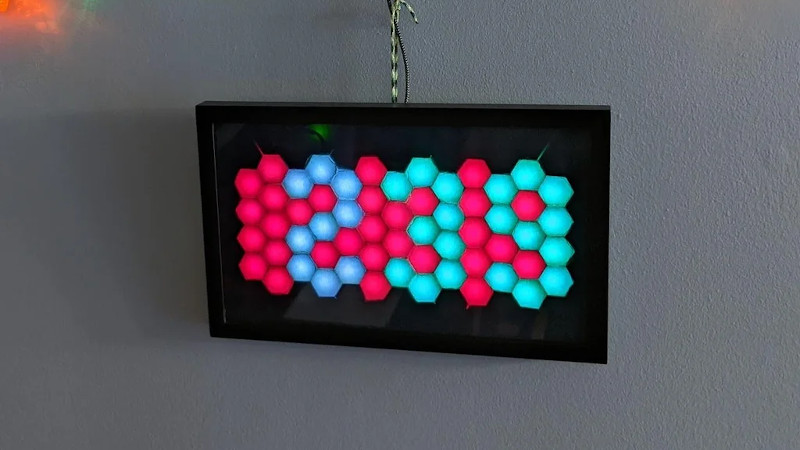LED matrixes were once a total headache, requiring careful consideration to make the most of limited I/O pins and available microcontroller resources. These days, addressable LED strings have made it all a cinch. Thus, going a little out of the box isn’t so daunting. [w.r.simpson] did just that with this hex-matrix clock.
Relying on hexes instead of a normal Cartesian grid requires some attention to how the rows and columns are laid out, but the Instructable goes through the necessary coordinate system to address the display. The whole display was built without a 3D printer, instead relying on some basic craft skills and a picture frame as the enclosure. Strips of WS2812B LEDs were used to build the hexagonal matrix, run by a Adafruit Metro Mini 328. To give each hexagonal pixel, or hexel, a crisp outline, a shadow grid was built using black paper to stop the light bleeding between the display segments when switched on. Smoked plexiglas wasn’t available, so instead, tinted window film was used to darken the front of the display.
The result is impressive; while some glue marks from the shadow grid are visible closeup, from a distance the final product looks incredibly futuristic thanks to the hexagonal layout. We can imagine this would make a great set dressing in a futuristic film clip; we fully expect to see this concept in the background of the next Ariana Grande single. If this build isn’t enough six-sided fun to sate your appetite, consider getting into Super Hexagon too!
















Doesn’t display 24 hour clock. I am disappoint.
I know it’s mentioned as a possibility in the Instructable, but I’d have preferred to see a 24 hour version with a mention of the possibility of a 12 hour version. Except that 12 hour digital clocks should not be possible.
Guy makes a cool thing, and all you can bitch about is the fact it isn’t the way you want it? Make your own.
Keep it up and I’ll make it a 6 hour display.
wouldn’t a decimal base (0-10) clock be better? 12/24 is so old-skool but 6 is a little confusing.
But seriously, nice looking project, it’s a display, it can display anything and if it scrolls it can display even more.
the Egyptians had a 10 hour day. plus an hour of morning, and hour of evening, and 12 hours of night.
He has published the code. Changing to make it 24 hours would be trivial. He obviously didn’t want that, so your comment is just gratuitous moaning.
Looks like it just needs a few more cells on the left to do that.
This is, in fact, mentioned in the Instructable.
You really are a meanie aren’t you? Does it feel good to antagonize and rain on parades?
If you were really mean, you could play with the colors so that colorblind people couldn’t read it…
Great project, extra impressive for being hand-built!
It’s interesting that my brain wants to focus on the red, and takes conscious effort to switch over to the blue/green to parse the numbers. I wonder if this varies from person to person
I wasnt having too much trouble but I did think it’d be a better display without them for higher contrast.
I focus on the red first but as soon as I recognizes the pattern (very quickly), I switch to the blue/green numbers and treat red as background. (I have been doing PCB for the last few hours.)
It is a bad choice of coloring.
I noticed the same thing! Actually it’s kind of annoying. Should be simple to “fix” in software.
The picture with the red background is actually captioned with this text:
“With the serial interface, you can play with the colors, which results in a few decent combinations and many terrible results as evident above, but you might find one you like”.
The image at the top of the instructable is a much better demonstration of it looking immediately like a clock.
Can I have a P please Bob? (one for UK hackers).
I’ll have a P please, Bob.
I thought of this when I saw this article: “https://hackaday.com/2020/07/26/hex-matrix-clock-is-spellbinding/”, but no time to explore further. I’m glad someone else has.